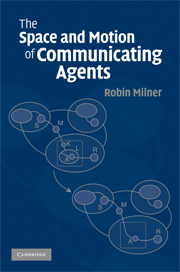Crossref Citations
This Book has been
cited by the following publications. This list is generated based on data provided by Crossref.
Walton, Lisa
and
Worboys, Michael
2009.
Spatial Information Theory.
Vol. 5756,
Issue. ,
p.
357.
Milner, Robin
2009.
CONCUR 2009 - Concurrency Theory.
Vol. 5710,
Issue. ,
p.
30.
Xue, Gang
Kong, Hongbin
Liu, Xiaodong
and
Yao, Shaowen
2009.
Notice of Retraction: Modeling Service Interactions in Term of Bigraphs.
p.
117.
Giudice, Nicholas A.
Walton, Lisa A.
and
Worboys, Michael
2010.
The informatics of indoor and outdoor space.
p.
47.
Bowles, Juliana
and
Meedeniya, Dulani
2010.
Formal Transformation from Sequence Diagrams to Coloured Petri Nets.
p.
216.
Zamudio, Victor
Baltazar, Rosario
Casillas, Miguel Angel
and
Callaghan, Vic
2010.
c-INPRES: Coupling Analysis towards Locking Optimization in Ambient Intelligence.
p.
68.
Wu Huai-Guang
Wu Guo-Qing
and
Wan Li
2010.
Bigraphical model of service composition in ubiquitous computing environments.
p.
658.
Goldsmith, Michael
and
Creese, Sadie
2010.
Refinement-Friendly Bigraphs and Spygraphs.
p.
203.
Bundgaard, Mikkel
and
Milner, Robin
2010.
Reflections on the Work of C.A.R. Hoare.
p.
213.
Hallwyl, Tim
Henglein, Fritz
and
Hildebrandt, Thomas
2010.
A standard-driven implementaion of WS-BPEL 2.0.
p.
2472.
Pym, David
and
Sadler, Martin
2010.
Information Stewardship in Cloud Computing.
International Journal of Service Science, Management, Engineering, and Technology,
Vol. 1,
Issue. 1,
p.
50.
Blackwell, Clive
2011.
Formally modeling the electricity grid with bigraphs.
p.
1.
Tomita, Kohji
Ikeda, Yasuwo
and
Hosono, Chiharu
2011.
Informatics Engineering and Information Science.
Vol. 253,
Issue. ,
p.
346.
Xu, De-Zhen
Xu, Dong
and
Lei, Zhou
2011.
Bigraphical Model of Context-Aware in Ubiquitous Computing Environments.
p.
389.
Wang, Ju-Shu
Xu, Dong
and
Lei, Zhou
2011.
Formalizing the Structure and Behaviour of Context-Aware Systems in Bigraphs.
p.
89.
Wang, Huanbao
2011.
Informatics in Control, Automation and Robotics.
Vol. 132,
Issue. ,
p.
59.
Murakami, Masaki
2011.
Advances in Wireless, Mobile Networks and Applications.
Vol. 154,
Issue. ,
p.
171.
Huanbao Wang
2011.
Indexed principal processes of concurrent cryptographic protocols.
p.
1279.
Stell, John
Del Mondo, Géraldine
Thibaud, Remy
and
Claramunt, Christophe
2011.
Spatial Information Theory.
Vol. 6899,
Issue. ,
p.
148.
Zhai, Huawei
Zhang, Weishi
Cui, Licheng
Shi, Jinyu
and
Li, Hui
2011.
Toward formal description to metro services mechanism based on bigraph models.
p.
285.



